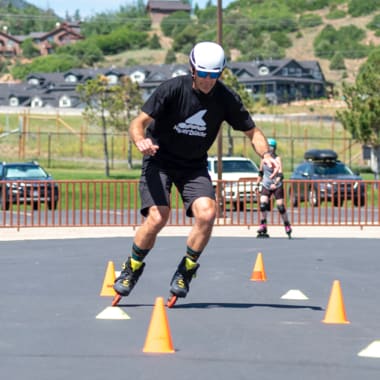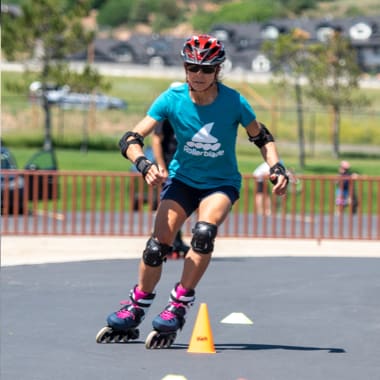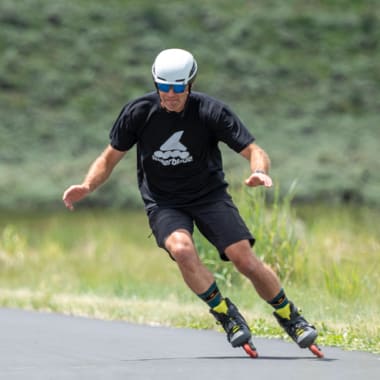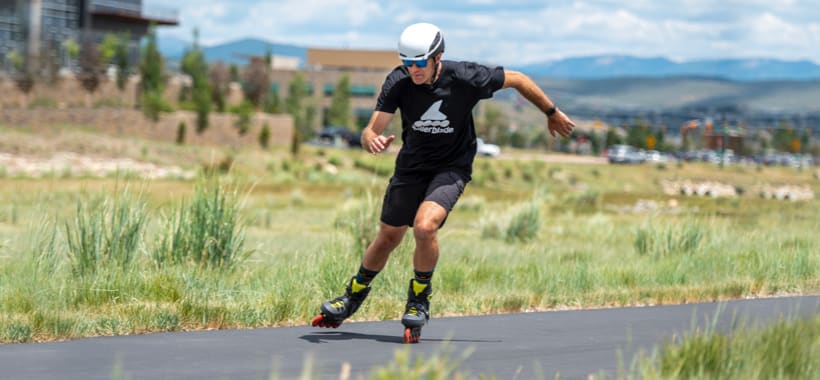
Europe
North & South America
Oceania

The following activities are intended to focus your attention on how you control your ankles and torso while gliding and if you can coordinate the two. Practice each activity as many times as you like. Each activity is described and demonstrated during the Gliding video. The key elements of each activity are also described below.

Lift the front wheel of one skate. As the front wheel is lifted, try to maintain an even fore/aft relationship between the skates. Hold the front wheel up for at least 2 seconds.

Lift the entire skate of the ground. Keep the skates parallel with the skating surface. Step slowly and deliberately.

Jump so that your skates leave the ground and maintain a parallel relationship with the skating surface. Land as softly as possible. Do this activity while hopping over painted parking strips if possible.

Repeat Activity 3 while jumping over a series of 4 - 6 ski poles spaced approximately 2 meters apart.

Glide over a speed bump or off of a curb. Keep the skates parallel to the skating surface and your helmet at the same height.
Once you are familiar with an activity apply each of the two cues described below to achieve or enhance your gliding stability.
The following activities are intended to focus your attention on how you control your legs and torso while turning and if you can coordinate the two. Practice each activity as many times as you like. Each activity is described and demonstrated during the Turning video. The key elements of each activity are also described below.
use cones are a chalk outline to create a half circle that has a 10 - 13 meter radius. Glide toward the circle, initiate and hold a single turn. Approach the circle from the opposite direction to practice your other turn.

as you near the start of the half circle, tip the buckle of your inside skate towards it. Hold it there for the entire turn.

as you near the start of the half circle, move your helmet towards the outside skate/away from the half circle.

simultaneously tip the inside skate towards the half circle moving your helmet away from the half circle.
Mark out a corridor using cones or chalk circles. Make the horizontal distance between each marker 6 feet and the vertical distance 3 feet. The corridor should be long enough for 4 turns. Make sure the corridor has alternating features: ie: a tall cone and a flat cone or a yellow cone and an orange cone (refer to video).

Turns will be made within the corridor by tipping the inside skate towards the dominant feature: i.e. the tall/orange cone. The distance between the skates will remain constant and fore/aft lead is minimal.

Turns will be made within the corridor by moving the outside shoulder towards the dominant feature: i.e. the tall/orange cone. Upper body is aimed down the center of the corridor.

simultaneously tip the inside skate towards one side of the corridor while moving the outside skate towards the opposite side of the corridor. The distance between the skates will remain constant and fore/aft lead is minimal. The upper body is aimed down the center of the corridor.
Once you are familiar with an activity apply each of the two cues described below to achieve or enhance your turning stability.
If the previous two modules have enhanced your balance then your ability to sense and create your own stability while gliding and turning should be better. Maintaining stability while transitioning seamlessly between gliding and turning is an ideal way to see how much you have accomplished. Practice each activity as many times as you like. Each activity is described and demonstrated during the Combo video. The key elements of each activity are also described below.

Set up a course like the one in the drawing (insert picture) Make the turn, then hop over the pole during transition and immediately move into the next turn after landing. The skates will stay parallel to the skating surface and the distance between the skates will remain the same throughout the challenge.

Set up a course like the one in the drawing (insert picture). Start a turn, return to a glide during what would be the middle of a normal turn and hold it, then initiate another turn, change edges and start another turn, return to a glide. Stance width will remain the same throughout.

Set up a course like the one in the drawing (insert picture). Start a turn, return to a glide during what would be the middle of a normal turn and hop over a ski pole, upon landing initiate another turn, change edges and start another turn, return to a glide and hop over a ski pole. Stance width will remain the same throughout and the skates will remain parallel to the skating surface during the hop.

You will propel yourself forward with a skating action that challenges you to tip the skate from side to side without extending until after the tipping action is complete. The specific sequence of motion is below:
Once you are familiar with an activity apply each of the cues described below to achieve or enhance your stability.